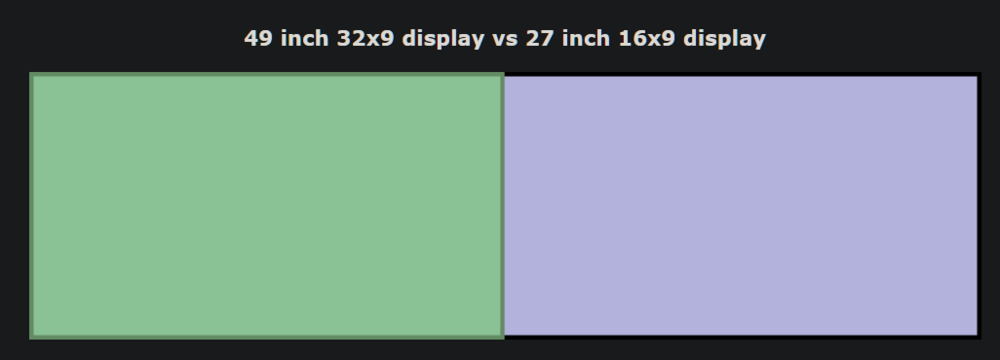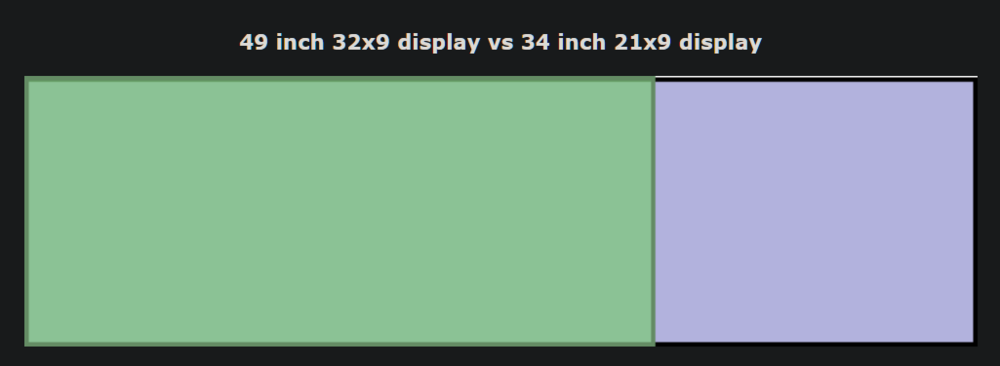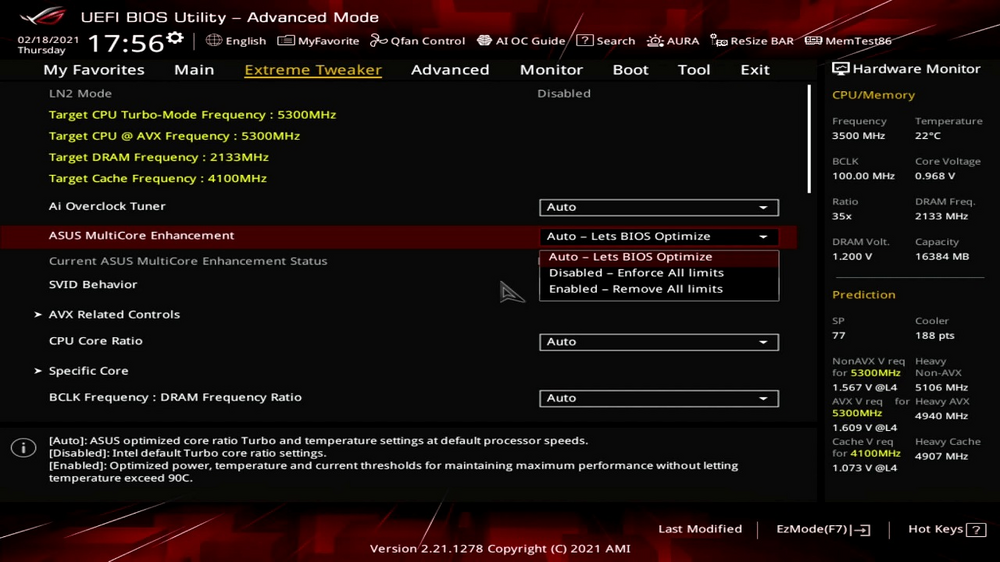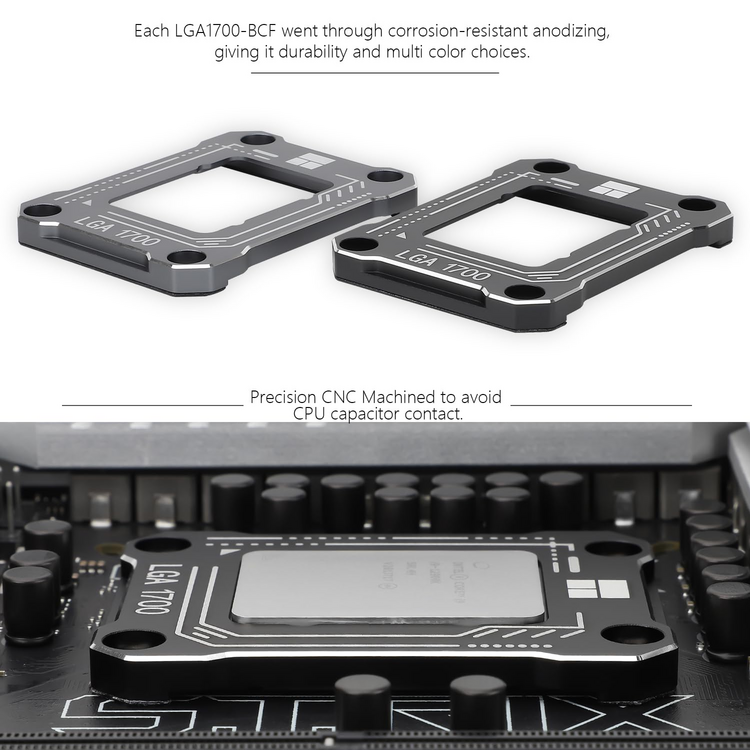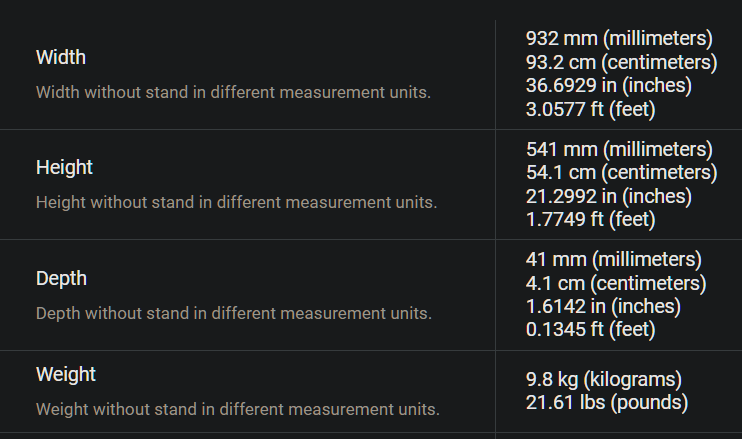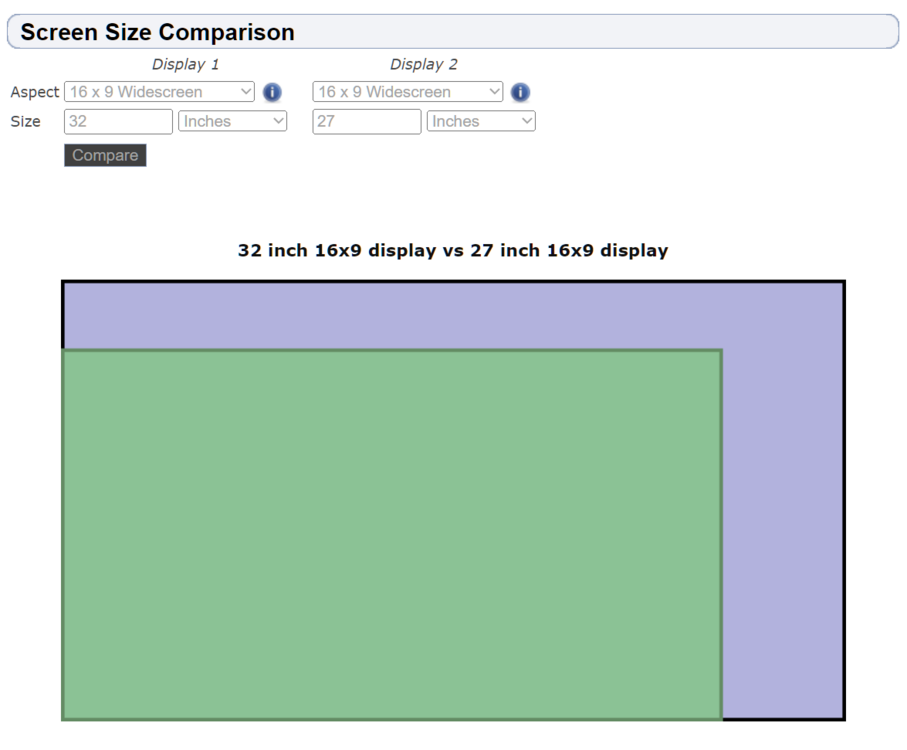-
Posts
1699 -
Joined
-
Last visited
-
Days Won
2
Content Type
Profiles
Forums
Events
Everything posted by LucShep
-
If you're going from triple screens to a 21:9 superwide screen with 34'' size, then I think it would be a downgrade, in my opinion. It's a smaller screen area, and you'll surely notice it. If you like the ultrawide aspect of triple-screens, if it's bezels bothering and higher resolution impact concern, then consider a 49'' 32:9 monitor, with vertical 1080P resolution. The 49'' 32:9 is equivalent to 2x 27'' 16:9 monitors. For reference, currently you're at 5760 x 1080 resolution with your triple 1080P screens, that's a total of 6220800 pixels. You'll notice latest 49'' ultrawides are 5120 x 1440 (1440P vertical resolution, total of 7372800 pixels - will be heavier on the GPU). But there are other 49'' ultrawides that are 3840 x 1080 (1080P vertical resolution, total of 4147200 pixels - will be lighter on the GPU). Whichever the case, budget at least $700 up to $1500 (depends on the model and its specs). For example, among other models, the Asus ROG Strix XG49VQ is a 49'' ultrawide that is 3840 x 1080 144Hz. It's a 2019 model (high-end back then, was $1300) currently being sold at discount prices ($800 more or less). In your case, it may be worth a look.
-

Looking for new VR PC Build ( Tips needed )
LucShep replied to Quekel's topic in PC Hardware and Related Software
Yep RTX 40 Super incoming: https://videocardz.com/newz/nvidia-teases-new-geforce-cards-on-the-horizon-rtx-40-super-incoming -

Looking for new VR PC Build ( Tips needed )
LucShep replied to Quekel's topic in PC Hardware and Related Software
That should definitely be reported to the website management of that partlist, because it's a silly error (and maybe not so inocent) that will end up forcing people to overspend on what they don't have to! Pick any ATX case you like, go to its specific product website. There, the only two things you need to take attention is that it must explicit say in product specifications that: 1) For the RADIATOR SUPPORT, that it allows for a 360 radiator (for your 360 AIO, ideally in horizontal at top, or alternatively in vertical at front - some will allow both!). 2) For the GPU LENGTH CLEARANCE, that it allows GPUs up to 390mm (note, Zotac RTX4080 Trinity is 355mm long, add at least 35mm to that if mounting radiator at the front!). As said previously when I posted suggestion of parts, the Lian Li Lancool III (~160€, very likely the best for that price) as well as the Lian Li Lancool 216 (~110€, and likely the best for that price) will allow room to spare for even the biggest GPUs on the market. EDIT: if interested, someone made a comparison video between these two cases. There should also be competing models of other brands with enough space as well. -

Looking for new VR PC Build ( Tips needed )
LucShep replied to Quekel's topic in PC Hardware and Related Software
That list seems good. Just my opinion but, the Corsair 7000D Airflow case is one of those examples of really overpriced (at 270€) and oversized cases (full-tower instead of mid-tower, why?) that are more "vanity pieces" than anything else. Plenty other cases will do the same job just as good, for half the price. -

Looking for new VR PC Build ( Tips needed )
LucShep replied to Quekel's topic in PC Hardware and Related Software
Before I forget, and since you are going for an Intel "K" 13th/14th gen based system, here's some small tidbits that may help... Intel 13th and 14th gen "K" processors are supposed to be good up to 100ºC, but keeping it under 85ºC is ideal. Better be aware of the following: Make sure that you peal out the sticker from the cooler's coldplate (the flat thing that actually touches the processor) before installing it. I know it sounds silly (looks too obvious) but it happens more often than you think! Get the Thelmalright Anti-Bending Buckle for LGA1700 (available in most places, including Amazon, Newegg, etc). Although not a necessity, it's a solution that is worth the time (and not complicated, watch the videos). The stock ILM in Z790 (and previous Z690) motherboards, unfortunately, doesn't ensure the best connection between the cooler's coldlplate and processor, and this thing solves that problem. You get better temperatures, as it should have been from the start. Motherboard manufacturers often use an "enhancement" setting that they leave ON (on "Auto") by default, in the BIOS settings. In my opinion, this should always be set to OFF (as "Disabled"), because leaving it enabled actually brings more troubles than benefits. That specific setting is "MCE" (MultiCore Enhancement). What this setting does is remove Intel's safety limits and applies even more voltage, to enforce turbo-clock on all cores (hence why many call it an irresponsible cheat). As far as long-term goes, MCE won't overvolt anything to dangerous levels, but it does make the CPU operate with (even more) higher wattage and temperatures. The thing of relevance here is, it provokes what it's not supposed to from factory. Just put that thing OFF (as "Disabled"), save and exit BIOS... and off you go. For example, in the case of ASUS it's usually seen there as "Asus MultiCore Enhancement". IIRC, on the TUF boards it's under "AI TWEAKER" tab, while on the ROG boards it's under the "EXTREME TWEAKER" tab (like image below). Different names but same thing. Regardless, it should look similar to this: -

Looking for new VR PC Build ( Tips needed )
LucShep replied to Quekel's topic in PC Hardware and Related Software
CPU: Intel i7 14700K This is, IMO, currently the best purchase of the entire Intel CPU line-up. That said, the previous i7 13700K is a great alternative if this system is strictly for gaming (sims or any other genre) as it's cheaper. If compared to the i7 14700K, it lacks four E-cores and is only three percent slower in gaming (which is negligible - runs any sim/game just as good). And no, you don't need the i9 14900K/13900K (the same eight P-Cores as the i7) for any current or soon to be released sim/game, VR or otherwise, for whatever GPU. If anyone says its miniscule increase in L3 cache and turbo-clock makes a difference, then I'm sorry to inform but it really doesn't. You just get more heat (even more) and pay dearly for it. CPU Cooler: a good 360 AIO For example, the Arctic Freezer II 360 (RGB or not). Great performance, pricing and quality/reliability. It may lack "bling" but its simplicity also makes it non-fussy to deal with. There are now 420 AIOs but they cost more, and not all cases allow for it. There's not a great deal of difference when gaming to 360 AIOs, unless if overclocking. Motherboard: a quality mid-range Z790 motherboard (250€ ~ 300€) For example, the ASUS TUF GAMING Z790-PLUS WIFI. Please note that for 14th gen Intel processors you need the latest BIOS update with most Z790 motherboards. Do not feel tempted to waste your money on "ubber super dupper" mega hype bling-bling expensive model of any brand, you don't need it even if overclocking. RAM: 64GB (2x 32GB) DDR5 6400 CL32 - this is currently the "best performance for the price" (64GB capacity) memory for an Intel 13th/14th gen sim/gaming rig. For example, GSKILL variations of these, such as the GSKILL RipjawsS5 F5-6400J3239G32GX2-RS5K and GSKILL Trident Z5 RGB F5-6400J3239G32GX2-TZ5RK. Corsair and their Vengeance equivalents as well, available with RGB and without RGB. STORAGE: a good pair of 2TB NBVME Gen4 For example, the Samsung 990 Pro (if with latest firmware in place!), Samsung 980 Pro, WD SN850X, Corsair MP600 Pro XT, these are all great NVMEs that are often recommended for the best reasons - high speed, very snappy and great reliabilty. From these mentioned, get the 2TB version you find at the cheapest price. If you want to save a little on the second (and/or third) NVME just to install games, then the WD SN770 is an awesome "cheap" option. Yes, it's RAMless (so not the best choice if using as a single NVME for OS) but it's fast and ideal for such purpose. And no, for storage you don't need NVME Gen5 at all for any sort of gaming. NVME Gen4 vastly exceeds any heavy gaming demands and is more affordable too. PSU: a quality 80+ Gold (or better) 1200W ATX3.0 PSU For example, the Bequiet! Pure Power 12M 1200W and the Corsair RM1200X SHIFT. - The Bequiet Pure Power 12M 1200W is awesome for the price, a great example of good quality without having to pay a fortune. - The Corsair RM1200X SHIFT is good quality and its peculiar "shifted layout" can make for easier/faster building (or changes) due to much better access to the connections (which are put out at the side, instead of the back). It doesn't work with every ATX case (see reviews of this PSU) but it does work with most. CASE: this is more complicated to suggest, because it depends on personal tastes and desires. For me, the best balance is found in the Lian Li Lancool III. Good build quality, layout and features, huge airflow, good looking and nice to work on, at a very reasonable price. There's also the popular Lian Li Lancool 216, although it's a more basic case, it too has good build quality and layout, great airflow, also nice to work on, and is cheaper. Any of these two have room to spare for even the biggest GPUs from Nvidia and AMD. Lastly, for the GPU, between the RTX4080 16GB and RTX4090 24GB there is a big price difference, same for heat and power-consumption... advantage for RTX 4080 16GB. The RTX4080 16GB should be all you need, but the RTX4090 24GB may provide you that extra bit of performance (+20%) and VRAM (+50%) to keep you happier with VR, from day one and for a longer time. ...it's up to you and your budget. -
Congrats @EmJay22 Enjoy the new bigger screen. Beyond the great specs, that P38UQ seems to be really top stuff from what I gather in user feedback. The "size impact" is perfectly normal within the first week or two of use. After all, from older to new screen you did jump 11 inches in screen size. Giving it a little more distance will help initially, but you quicky get used to it, you'll see. The thing I'm curious about is the 4K resolution clarity. My 43'' Toshiba had it already very good at 103PPI (far better than the current 50'' Philips, but it's the price to pay for bigger screen at same native resolution). But that thing, at 38'' with 116PPI, that must be insanely clear at native resolution (3840x2160), given the considerable large size for a monitor screen. Oh yes, that's very true!!
-
No problem, glad if it helps. If you want something between the 32'' and 42'' size, well, then you might be in luck! ASUS recently revelead the world's first 38'' 4K high-refresh gaming monitor, the ASUS ROG Swift PG38UQ. And it's available (at 1000$). It's a 38'' size, 16/9 format, 3840x2160 144Hz VRR display gaming monitor, with IPS panel. It seems to be also RGB sub-pixel layout (so, perfect text clarity). A bit expensive, but looks like it checks all the right boxes. Newegg: https://www.newegg.com/p/N82E16824281268 Amazon: https://www.amazon.com/ASUS-Swift-Gaming-Monitor-PG38UQ/dp/B0BZR81SQG/ref=sr_1_3?keywords=PG38UQ&qid=1702762828&sr=8-3 I didn't even knew about this one. Heck, this might become now one of the most recommended monitors for DCS folks.
-
Avoid that one. Two problems, the VA panel and the outrageous price. VA panel will never be as good as IPS for motion handling, no matter the processing behind it. It's inherent to the panel tech, there's always a bit of blur and smear on fast moving objects and scenario. What VA does better than IPS is contrast-ratio (higher whites and lower blacks) which is very sought for HDR based content, or for games focusing on extremely bright or dark tones (manga/cartoon style, or horror ones). This of no importance for DCS. IPS panel is better for DCS, always, every single time. The clarity in motion (motion handling) is really important especially with TrackIR, when you need to focus something same time you maneuver, like you would in real life. You'll notice it once in the air and head-tracking, for example in BFM, over forests, or focusing on objects. It's not just that it is more effective, it's how naturally it feels when compared. Then the price, no 32'' display is worth 1000$ (and over), much less VA panels from Samsung (and others) know to be overpricing their monitors (and TVs!) for years now. Also, noone using 4K needs 240Hz refresh (it's great for marketing though!). 144Hz with 4K is already outstandingly good, even 120Hz is excelent for a 4K screen. If you already decided 32'' size in 16/9 format is prefered, and desire a quality 4K high-refresh panel (for DCS but not only), I think these three are what you should be targeting: Gigabyte M32U - RTINGS review: https://www.rtings.com/monitor/reviews/gigabyte/m32u - Newegg: https://www.newegg.com/p/N82E16824012042 - Amazon https://www.amazon.com/GIGABYTE-FreeSync-Compatible-3840x2160-Response/dp/B083GRVFXN/ref=sr_1_3?crid=29K39YUK02GPS&keywords=M32U&qid=1702754017&sprefix=m32u%2Caps%2C214&sr=8-3&th=1 LG 32GR93U - RTINGS review: https://www.rtings.com/monitor/reviews/lg/32gr93u-b - Newegg: https://www.newegg.com/black-lg-ultragear-32gr93u-b-32/p/N82E16824026380 - Amazon : https://www.amazon.com/LG-UltraGear-3840x2160-DisplayHDR-DisplayPort/dp/B0C633799X/ref=sr_1_3?crid=1S7SG1HCP78DA&keywords=32GR93U&qid=1702754096&sprefix=32gr93u%2Caps%2C290&sr=8-3&th=1 LG 32GQ950 - RTINGS review: https://www.rtings.com/monitor/reviews/lg/32gq950-b - Amazon : https://www.amazon.com/LG-UltraGear-32GQ950-B-DisplayHDR-FreeSync/dp/B0B355VFH7/ref=sr_1_3?crid=3279G9ADWWA9C&keywords=LG%2B32GQ950&qid=1702759511&sprefix=lg%2B32gq950%2Caps%2C171&sr=8-3&th=1 With all that said, I still think a 32'' 1440P IPS gaming monitor is still the best balanced choice, for 99% of people looking to use DCS at that particular screen size. The Gigabyte M32Q, Asus TUF VG32AQL1A, LG 32GP850 and LG 32GP750 are all great gaming monitors in this segment, found around 400$.
-
I have to say, I always loved an overkill sized screen, still do, but... that statement turned out to be true for me as well (for flight sims anyway).
-
Good post @Nazgûl that's nicely detailed and exemplified. I kind of relate with your issue... At some point I didn't know what to do with my old 7.1 speakers/tweeters+sub system that I held on for years and years. One day I realize I can't live anymore with the space restrictions and so many cables around. My constant "evo versions of the man cave" instead had transformed into something opposite to my ideal "comfortable personal zone" once envisioned. haha Some space restructuring and recycling followed... best thing I did then. I love headphones, so kept mine, losing the complicated sound system was not too hard after all. You don't like headphones, so in your case I think the best solution could be trying a soundbar system (and store all the speakers away). It's same principle as you see now for big TV's, but for PCs and gaming instead. One bar below the screen, usually "fits" the space, it's simple, looks clean and neat, good sound to make you grin. Plenty brands and models at wildly different budgets, compact or large, systems from 2.0 to 7.1, gadgets galore or simplistic, with or without sub-woofer. Many articles around about it, this long one also with recommendations is as good as any: https://www.soundguys.com/best-computer-soundbars-75253/ If you're not sure on the idea, get something really basic and inexpensive, just to see if you gel with the idea and concept. With a 42'' screen right in front of the face, I think most will feel that 27 inches (70 centimeters) from it is the minimum comfortable distance, you won't like it being too close. Regardless, jumping so much in size of screen will always be a bit of a shock in first days of use. Each person is different, of course, but one gets accustomated quickly. Hey, I remember gaming on CRTs, first a 13'', later a 15'', then onto a brand new 19'' to substitute it and thinking "wow, that's definitely the maximum sized screen one would ever be comfortable with!!" ....over 20 years later, that didn't age well. Unless you get a really big screen (43'' and over), I personally don't think you'll ever see a need for a curved-screen. Also, flat-screens fit in a desk much better. I do miss my old '55 curved Samsung NU8500 (then placed on a vertical stand at front of desk, not over it), but that thing was just friggin ginormous. Better take a walk at the mall or a store where you get to see those screens, sometimes it's enough to understand if it's what you envisioned or not. Maybe entertain the idea of simulating how it'd go and fit in the place, by cutting some cardboard paper or something the size of the screens you're looking at. 32'' 16/9 screen, estimated dimensions: 42'' 16/9 screen, estimated dimensions: 34'' 21/9 screen, estimated dimensions: Matter of budget, desk and space for (and from) the monitor, how you'd feel about it being 1) bigger, 2) much bigger, or 3) just larger at the sides than the one you have....
-
32'' is definitely a noticeable increase coming from 27''. ...do you imagine downgrading to a 22''? (those tiny little things heh) Now compare your 27'' to a 34'' SuperWide: If your desk is short and you're forced to be very close to the monitor, then of course a 42'' is probably out of the equation but, just look at the scale......... The in-game cockpits (everything really) then start to feel a LOT more "real life like" (LG 42'' OLED C2 or C3 are really, really good, I tell ya) PS: comparisons from https://www.displaywars.com/
-
It depends on various things... It depends on the system you'll be using DCS with that new screen. You seem to have a 2560x1440 27'' screen. How much are you seeing in the GPU usage? If you're already seeing over 80% of GPU usage at that resolution, then at 4K you'll certainly hit 100% with the same settings, forcing you to decrease settings. On the other hand, with the recent inclusion of DLAA, TAA, and DLSS, you'll certainly manage a compromise with settings that can make you really satisfied. It depends what you value most, more resolution or more framerate. The jump in clarity and definition from 1440P to 4K is as big -if not bigger- than 1080P to 1440P. It's that good. But it's still very intensive after all these years - it does push the GPU to its limits at a certain point... forget 90+FPS everywhere and all the time in DCS at 4K, it won't happen. As to say, if you're the type of person that "it always has to be 120+FPS all the time, period" then DCS in 4K is probably not for you. Especially if not using the very best hardware. It depends what you value most, vertical depth or horizontal depth. Widescreen format, either in 21:9 (super-wide) or 32:9 (ultra-wide) really is an acquired taste. You should definitely try it first, it may or may not work for you. Some swear by it, and it does have its pluses depending on application. For example, for sim-racing the big curved ultra-wide 49'' monitors are excelent. But then, we're talking flight-sims + TrackIR here.... and in this particular scenario (DCS and others) I personally don't think it works all that well. You lose the immersive vertical depth that a regular 16:9 screen provides, and is an important factor you'll be missing. Personally, I felt like "something is missing", as if the top of the screen was chopped off (I regretted it... never again). In regards to the spotting in DCS, even with latest updates, it's still mediocre regardless of resolution (IMO). I do not think this should be considered as a decision factor for your new screen. The immersion, the clarity, definition, motion handling, crispness of colors, overall image quality, now those certainly are. I'm sure opinions will vary but, I'd really recommend two potential paths in 16:9 format, first because they are safe bets for DCS and, second, because in your case it's basically taking what you already seem to like and make it "bigger, more better" : A good 32'' 2560x1440 (1440P) monitor is fairly affordable now. Yes, the pixel density is lower compared to your 27'' with same resolution (equivalent to that of a 24'' 1080P screen), but still very good on a bigger 1440P screen that is also easy to run (same as you have in that aspect). There are OLED panels at 32'' size, but they're too pricey for the size (IMO). Models with IPS panel are affordable and the better choice for this size, with good overall quality and no ghosting/smearing issues with fast moving images (likely to happen with VA panels and why some avoid these). Examples: Gigabyte M32Q, Asus TUF VG32AQL1A, LG 32GP750 and 32GP850 (these are all IPS) A good 43'' or 42'' 3840x2160 (4K) monitor can be expensive and a little harder to run but is, most likely, the choice that will knock your socks off. IPS panel would be good but don't know any high-refresh model (LG 43UN700-B is 60Hz only, ok but not "wow"). There are some with VA panel (Samsung, Asus, etc). An OLED panel is definitely the best of all (excelent) and very worth a look - if it's for pure gaming use (burn-in risk factor). Examples: LG C2 42'' and C3 42'' (OLED, 120hz) I'd even recommend a 48'' 4K OLED, but then we're entering a whole'nother level of "bigger more better"....
-
Yep, it's far from a perfect solution, and the main problem with DCS 2.5.6. Any of today's content that was already available then (March of 2021), and as of that version release, runs much better there (in my experience and of many others), inclusively online if with people using that same version. But you're left behind with what already exhisted back then, as explained in its download page details. As to say, if you're an advocate for MP public servers, and/or of latest updates/fixes, and/or of most recent content (modules, campaigns, etc), then it will not serve you. There was loads of content already (actually most of today's) and plenty campaigns available at the time for a plethora of modules. It might be the case for yours (see in the DLC page which version it requires). If you're intrigued, and if you have the drive space, my suggestion is to give it a good go and see how it works for you. For me, I'm finally enjoying DCS in VR, no more frustration with framerate, frametimes, stuttering and whatnot, and can inclusively run higher settings. And as much as I was antecipating upcoming content (Mig-17F, A-7E, Kola), my conclusion is that the performance benefits, as of today, are too good with 2.5.6 to ignore it. Not going to suck it up with the issues and/or upgrade perfectly capable HW just to keep up with the joneses. Not again.
-

64 GB RAM is not enough anymore?
LucShep replied to Steel Jaw's topic in PC Hardware and Related Software
Hey, call it what you will. I just believe that ED should solve this versus everyone just having to throw hardware at it. -

64 GB RAM is not enough anymore?
LucShep replied to Steel Jaw's topic in PC Hardware and Related Software
Not sure I understand... and pardon my rant here if I misunderstand. So we should start accepting to have 56GB+ RAM and 24GB+ of VRAM usage ingame, in 2023? And even worse in next two or three years? If I've read it correctly, and if that's what it means, then I'm sorry but that's stupid. On a hobby that is already pretty demanding and expensive as is. I was watching that video from Jabber's mesmerized thinking "how did we get here?!"? - he seems to have a top of the line PC, and the OSD figures there are alarming. I'm currently running DCS2.5.6 (just my preference) and, with the same modules and maps, I can not understand where to justify the RAM, VRAM, CPU and storage much(!) higher usage in version 2.9, to warrant the "step up" - it's not even a different, brand new DCS game. IMHO, it should be contested and criticized by everyone (we're all paying customers after all). But, instead, it seems people prefer to pony up for overkill hardware, in a desperate atempt to disguise issues that should not exhist. -

64 GB RAM is not enough anymore?
LucShep replied to Steel Jaw's topic in PC Hardware and Related Software
Perhaps this might help alleviate what may be oversaturation of IO operations, due to to many threads running at the same time. It's worth a try. In anycase, it does show DCS is able to exhaust the VRAM even with a 24GB GPU (and that seems 1440P, not even 4K, not VR) and system exceding 59GB of RAM usage(!?!). It just looks silly that a sim/game, already a monster eating resources a few years ago, got to be this demanding. But at least it seems ED is on it (fingers crossed). @Steel Jaw I'd suggest to try Taz' Optimized Textures. It'll alleviate a bit the outrageous VRAM consumption (and how the textures should have been from the start). -

64 GB RAM is not enough anymore?
LucShep replied to Steel Jaw's topic in PC Hardware and Related Software
I've seen 42GB online quite often and already found it absurd, but 63+GB ?? That's certainly not normal! Your RTX3060Ti is a bit short with its 8GB of VRAM, and DCS easily consumes upwards of 14GB VRAM if online. Then it starts to eat RAM and pagefile to compensate. That said, I'd take a screenshot and present it as a bug in the respective section. No sim/game should ever consume that much RAM. -
No, no need to to wait or to get DP2.1 hardware for 4K in DCS. DCS is not the kind of game you expect super high framerate (actually the opposite), so the bigger bandwidth with newer standard won't make any difference for it.
-
I found the X56 throttle to be actually decent (the stick not so much), can be a good purchase as these days it's found fairly cheap in the used market. Its known issues can be easily remedied taking the following things as a rule for it: LEDs always OFF in the Logitech software, pretty much a requirement to avoid any issues. Better make sure as well to connect it through a self-powered USB HUB. No need for expensive ones, cheap ones like TP-Link UH720 ($25.00) are absolutely fine. Do the following for both the throttle and stick, to solve ghosting and jittering problems (usual in throttle and rotaries, also happen with the X52 and X52-Pro), by using Vjoy +Joystick Gremlin, following this tutorial:
-
I agree with @BitMaster. Even though DDR5 is better in this regard than DDR4 was before, it is clear that the rule still persists - two sticks of RAM are always better than just one. The main advantage is higher memory bandwidth, higher access efficiency, and lower latency. It's all better with two sticks (instead of just one). DDR5 is much cheaper than before, there is no reason to not get a Dual kit (say, 2x 32GB or 2x 48GB) that is meant to be installed and run in that configuration. All these Intel and AMD processor based systems that we go for are designed to run ideally in Dual-Channel memory configuration. Especially if you're already spending on a system, not doing it is counter intuitive. It's neglecting a particular part of the system performance that most people here crave for. There are plenty articles and videos explaining this in a more cientific aproach (and with tests). This one for example is a bit old (dates from when DDR5 was out and too expensive, and DDR4 mobos for 12th gen were a better compromise) but have a listen from 3:19 and on:
-

Help Needed: AMD 9 7950X3D CPU and DCS VR Performance
LucShep replied to Gideon312's topic in Game Performance Bugs
I don't have a Ryzen 7950X3D, but its issues are well known in the HW community. You may be already very familiar with the following but, in anycase... The AMD 7950X3D is a dual chiplet design CPU. It gets more complicated because it has 16 cores, but only 8 of them make use of the 3D V-Cache. IIRC, CCD 1 (chiplet one) is the CCD with the 3D V-Cache, so make sure that the game is only worked on (CPU affinity) by those 8 cores with 3D V-cache, and not use the CCD 2 (chiplet 2) with games. I presume that would mean creating the affinity to logical core 0-15 with the 3D V-Cache (and 16-31 without). Something like Process Lasso may be the better way to create settings to automatize affinities, very usefull with a 7950X3D. -
Yes, pre-rendered frames depend on CPU but it actually works the opposite way - more pre-rendered frames aliviates the CPU. Adding pre-rendered 3 (and up to 4) lets your GPU stack them up, at a small cost of latency (unnoticed in a flight sim - i.e, no downside in this aspect). So if your CPU ever struggles to keep up (likely case in DCS), you can tell the GPU to let X amount of frames pre-render. Pre-rendered value at 1 would be ideal in a world where this sim never, ever, stutters or hitches. But alas.... "DCS" Pretty much everybody in DCS VR is, unfortunately, running the game smoothly for a limited time only, with the odd hitch or stutter always creeping in. Therefore should try setting it to either 2, 3 or 4 frames to help smooth them over. I think benefits vary between values, and can be debatable (through empirical and quantitative testing, etc). Best way is to try it out yourself and see what looks/feels better. For me, it certainly makes a difference, for the better (prefer it set at 3). Could be different with 13900K + RTX4090, but it won't necessarily work better. "Default" adds performance penalty, more stressful due its higher projected accuracy. Even if with lower cascades (mod in my sig). The odd thing for me is that, Terrain Shadows from OFF to FLAT with game versions up to 2.5.6 used to get virtual zero GPU frametime cost. But they can cost about 15%~25% ever since version 2.7 got out, and it remains like that with 2.9 today (and 2.8 before). Therefore why I always use them OFF and recommend so, for VR. ...one reason (among various other reasons) why I got back to version 2.5.6 for VR and never looked back - Terrain Shadows (Default or FLAT) can be used with far less issues.
-
No problem. If you just want get back to 2.8, then maybe just download and install the current Stable version - that's still 2.8. If you're looking to rollback your current installation to a specific OpenBeta version, then it's a little more involved... I covered that in another thread recently, the principle is the same as in HERE. You just look for the desired version ID, and follow those same guidelines for it.
-

Graphics Card Upgrade Opinion Wanted
LucShep replied to Jetguy06's topic in PC Hardware and Related Software
I concour. I still adore my RTX3090 24GB, but wouldn't mind swapping it for a good RTX4080 16GB if the opportunity was given. It has less VRAM (16GB vs 24GB) but that's plenty, and it's overall faster (+25%) while being more efficient (~50W less at peak consumption, ~320W vs ~370W). Very expensive but may be worth it for someone coming from an older GPU, considering the current sad state of the HW market. Regardless of choice, and if you're spending for DCS VR, avoid any GPU with less than 12GB of VRAM, and better if it's 16GB or more. If you're OK with used hardware, there may be some deals worth looking at (Ebay, etc) for RTX3080Ti 12GB and RTX3090 24GB. Otherwise, if it really has to be brand new, RTX4070Ti 12GB or RTX4080 16GB would be my pick. PS: rumour has it that NVDIA will be releasing the RTX 4000 Super series refresh, from start of next year (2024). You may want to wait (or not) and see if the RTX 4070Ti Super 16GB is a reality, like the info leaks suggest.


